Floral and Grape
by Dr. Larry Keig
Dugan and Diamond produced Floral and Grape, as did Fenton. Distinguishing what was made by one manufacturer from the other is really not all that difficult.
The Floral and Grape patterns are attractive, even as the combination of design elements is seasonally incongruous. Both firms’ patterns feature early-to midsummer flowering daisies and late-fall ripe grapes and leaves, elements that do not have concomitant life in the botanical world.
Pitchers made by both companies are bulbous, crimped around the top, have factory attached glass handles, and are mold blown. Tumblers are pressed with three molded panels.
Besides water sets consisting of a pitcher and tumblers, one manufacturer also made JIPs shaped from the tumbler. The other firm created a large vase made by reshaping the top of the pitcher and dispensing with the handle. This firm also made a pitcher that is a variant of the conventional design.
Dugan and Diamond Floral and Grape
The animate elements of Dugan and Diamond’s Floral and Grape are grapes, leaves, vines, and daisies, or daisy-like, blossoms. Visually, the design is all encompassing.
Pitchers
The principal elements of Dugan and Diamond Floral and Grape pitchers are six grape clusters, eight large leaves, grapevines, and ten daisies and their leaves. These elements cover nearly all of the front, back and sides.
Two ribbons—one encircling the belly, the other the neck—are crucial in differentiating the Dugan and Diamond pitchers from the Fenton. The diagonal lines on both ribbons of the Dugan and Diamond tilt to the left and are banded by raised cables above and below each ribbon. The ribbon at the midsection is one and three-eighth of an inch wide, the one around the neck five-eighth of an inch.
The pitcher is approximately nine and one-half inches tall, its base diameter four inches, its top diameter six or so inches, and its circumference at the widest point 23 inches. The top is an irregular loose crimp. The three mold lines are largely obscured by leaves and vines. The interior surface is unpatterned.
Confirmed colors are marigold, amethyst, white, cobalt blue, and lime green with a marigold overlay (sometimes called Afterglow green). The marigold and amethyst are available. The white is a bit harder to find. The blue and marigold over green rarely surface. The factory fused handles are non-iridized crystal. They are clear on the marigold and white, purple on the amethyst, cobalt on the blue, and a bright lime on the marigold on green.
The base color of blue Dugan and Diamond pitchers and tumblers (and their other blue items) tends to be an intensely deep cobalt. Connie O’Connor’s cobalt Floral and Grape pitcher, shown front and back, is illustrative of not only the base color but also the capaciousness of the pattern from all directions. She has also observed that Dugan pitchers look chunkier to the eye than the leaner Fenton, observations borne out by measurable differences in their circumference.
While a general collector, Connie has specialized to some extent in Dugan blue and pitchers. Thus, the cobalt Dugan or Diamond pitcher she found in Bill and Sharon Mizell’s room at a Mid-Atlantic jamboree several years ago interested her. She is a member of several carnival clubs, including ICGA, and attends conventions when she can, especially those near her home, like the Keystone and Mid-Atlantic.
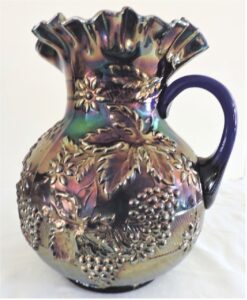
The pattern of Dugan-Diamond Floral and Grape pitchers covers most of the surface. Cobalt blue pitchers like the illustrated are scarce.
Tumblers
The defining elements of the Dugan and Diamond tumbler are six daisies, six grape clusters, six leaves, vines, and a ribbon at its midsection. Its three mold panels are nearly identical in the distribution of pattern elements.
The appearance of the ribbon and the placement of the blossoms, grapes, and leaves distinguish the Dugan and Diamond tumblers from the Fenton. The Dugan and Diamond ribbon is banded above and below by raised cables. The daisies appear on the left side of each mold panel. One grape cluster and one leaf are situated entirely on the right side of each panel; the other cluster and leaf straddle the mold lines, camouflaging a sizable portion of the seam.
Tumblers have been confirmed in marigold, amethyst/ purple, white, and cobalt blue but not in marigold over lime green. The marigold, amethyst, and white are easy to come by. The cobalt blue is next to impossible to track down. Tumblers have been said to exist in standard (as opposed to lime) green but there is no photographic evidence to support that claim.
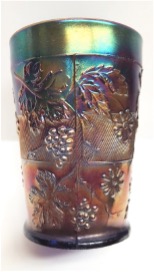
One large leaf and one grape cluster overlap each mold line of Dugan-Diamond Floral and Grape tumblers. The cobalt, like this one, are rarely seen.
The illustrated cobalt tumbler is from Bob Smith’s collection. It is unusual in that the iridescence is multicolored rather than the all-too-familiar silvery iridescence of Dugan and Diamond blue.
Over the years, Bob Smith accumulated more than 1600 different tumblers, almost unquestionably the largest carnival tumbler collection in the U.S. For decades, he, along with John Britt were considered the foremost authorities in that field. Since shortly before Bob’s death, Christina Katsikas has been caretaker of the collection. She has indicated that she plans to display all of it at the 2019 Tampa Bay convention.
Until his health declined, Bob was active in the New England Carnival Glass Association. He contributed regularly to NECGA’s newsletter through the August 2012 issue, writing on both domestically and internationally manufactured tumblers. (NECGA’s editor Kris Dorais looked in vain for articles by him on Floral and Grape, which, had they been available, may have informed this one.) He also attended conventions where he’d display the rarest and other tumblers from his collection, some of which were obtained from travel abroad.
JIPs. Hats in the jack-in-the-pulpit shape were configured from the tumbler mold. The only color that has been confirmed is a not-all-that-difficult-to-find marigold. The marigold overlay on the JIPs is usually darker at the bottom than at the top, probably because pulling the JIP top into place diffused the surface color.
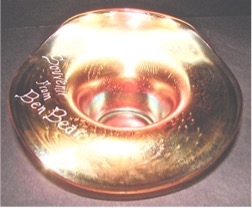
Floral and Grape JIPs with souvenir lettering like the illustrated Ben Bear are more difficult to find than those without.
JIPs are sometimes hand lettered. The pictured example, from Barb and Don Chamberlain’s collection, is the Ben Bear souvenir. Ben Bear was a clothing store, named for its German-Jewish immigrant founder. It operated (under his ownership) in Decorah, Iowa, from 1876 until his death in 1938. The souvenir was likely gifted to customers sometime between 1910 and the U.S. entry into World War I.
Ruffled hats are also said to exist, but there is no record of any having sold or having been photographed. The same can be said for the availability of JIPs in amethyst.
Dugan and Diamond water sets appeared in wholesale catalogs from 1912 through 1919. They may also have been marketed prior to 1912 as the lion’s share of white carnival was made during the Dugan years. The pitchers were almost certainly produced beyond 1919 as Afterglow green was introduced in the late 1920s. It is possible there was a hiatus in production after 1919 with a re-introduction of the pitcher in the late Diamond years.
Fenton Floral and Grape
Fenton’s Floral and Grape is simpler in design than the Dugan and Diamond. The Fenton pitcher has considerably less patterning on its back than front, with much unpatterned area on the reverse.
Pitchers, Conventional
Pattern. Most of the patterning is found on the front (handle at right) where there are three grape clusters, three large grape leaves, grapevines, and six daisies with leaves. The reverse (handle at left) is sparsely patterned. There the design consists of a single cluster of grapes, large and small grape leaves, and grapevines.
The appearance of the ribbons at the midsection and neck is also critical in distinguishing the conventionally designed Fenton pitcher from the Dugan and the Fenton pattern variant. On the Fenton conventional, the diagonal lines of the ribbons tilt right. They have no raised bands above or below the ribbon, and the ribbons are relatively indistinct, especially at the neck where it is sometimes barely visible. The midsection ribbon is one and one-fourth inches wide; the neck ribbon, one half inch.
They are nine and one-half inches tall, give or take a little. Their top diameters range from five to five and one-half inches. The base diameter is four inches. The girth at the widest point is 22 inches. The top is an even tight crimp. Mold lines, only partially covered by the pattern, are clearly visible. The majority have plain interiors but some have a Drapery pattern on the inside. The Chamberlains’ green Floral and Grape illustrated has this Drapery interior.
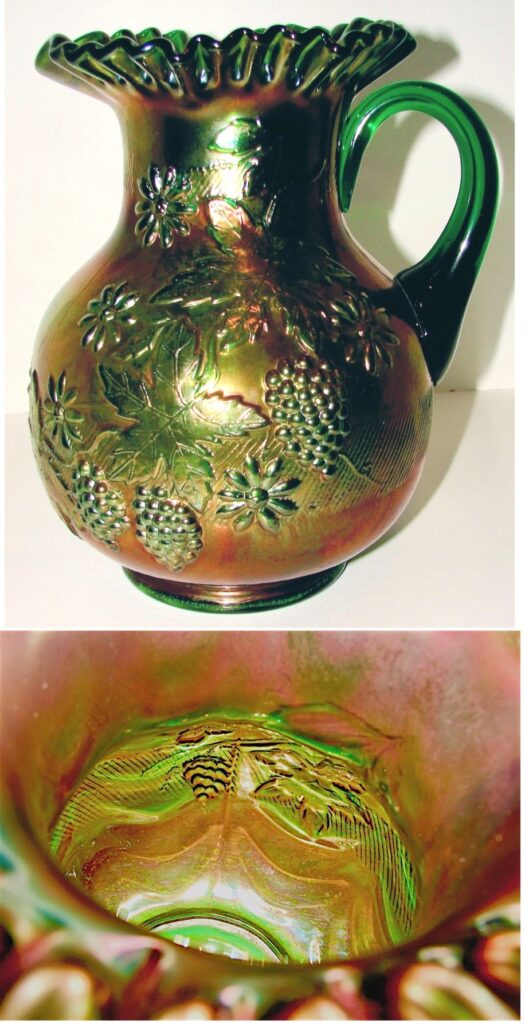
The ribbons of Fenton Floral and Grape pitchers are unbanded. Most are unpatterned on the inside but a few, like this one, have Drapery.
Pitchers are known in marigold, amethyst/purple, a medium blue, and a standard green. None have been confirmed in white. The marigold is available. Unlike the scarce Dugan and Diamond, the Fenton Floral and Grape pitcher in blue is the most common color. The amethyst and green are seen infrequently. The crystal factory attached handles are dark versions of the base color except for the marigold which is clear.
Tumblers
The patterning of Fenton Floral and Grape tumblers is equally divided among three mold panels. Within each are two grape leaves, two grape clusters, and two daisies along with grapevines. A wide ribbon encircles the tumbler’s midsection.
The appearance of the ribbon and the placement of the other pattern elements distinguish the Fenton tumbler from the Dugan and Diamond. There are no raised bands above or below the ribbon of the Fenton. On the Fenton, the grape leaves have been placed on the left side of each mold panel, the grape clusters in the center, and the daisies at the right. There is no blending of pattern elements from one panel to the next so the mold lines are completely exposed.
Tumblers are available in marigold, amethyst/purple, medium blue, and standard green. The marigold and blue can be found with little effort. The amethyst is less available. The green is not only tough to track down but also next to impossible to find with nice color. None has been confirmed in white. Collectors can be about 99.9 percent sure that pitchers and tumblers described as white Fenton are actually Dugan.
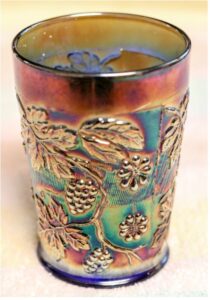
The pattern of Fenton Floral and Grape tumblers is confined to each panel with no overlap of mold lines. The “Tilton tumbler” is illustrative.
The illustrated blue tumbler with bright surface color once belonged to Emma and Dick Tilton, longtime collectors and dealers from Ohio. Emma, who may have been drawn to collecting by her mom who was herself a collector, was ACGA president from 1986–1989. For years, she clerked and Dick handled mail bids for auctions run by Tom Burns. At these events, they acquired some of the glass they sold out of their room at Midwest carnival conventions.
Vase
Fenton created at least one vase from the conventional pitcher mold. If it had a handle and a spout, it would be an atypically shaped pitcher. Instead, a finisher created a whimsey vase, as Dave Doty felicitously notes, by “necking in the top” but not applying a handle or drawing out a spout.
Apparently a one-of-a kind, it is eight inches tall. Its top diameter is seven and one-half inches, its base diameter four inches, and its circumference at the widest point 22 inches. It has a smooth top edge, not the tightly crimped top found on pitchers.
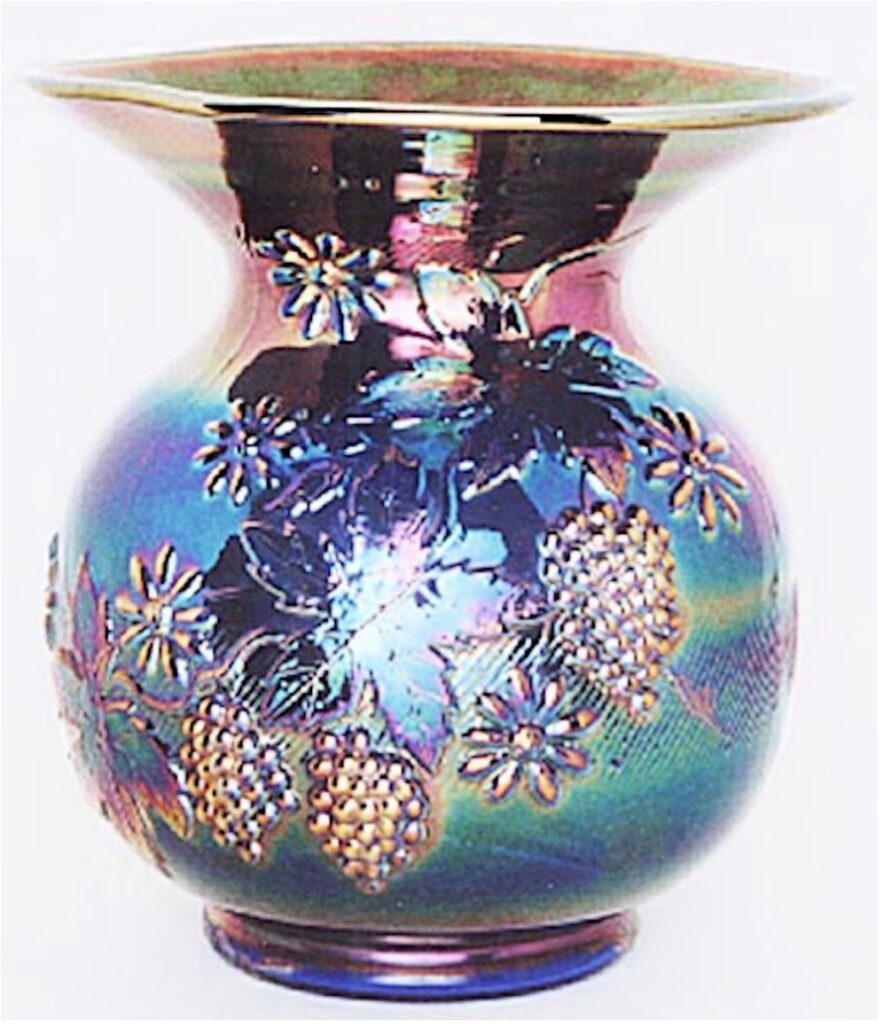
The whimsey vase is the Cadillac of items in the Floral and Grape pattern. It looks much different from the pitcher from which it was derived.
The vase has been in Don and Becky Hamlet’s collection for 30 years or more. How they acquired it is an incredible story. They found it, of all places, at a weekly consignment auction where only one other buyer knew much about carnival and with whom they struck a deal, a captivating story of its own. So, bottom line, they didn’t overpay. (An experience most of us can only dream of.)
Pitcher, Pattern Variant
Fenton produced a pitcher in a pattern variant as well as pitchers with the conventional design. The variant has no ribbons around either the midsection or the neck. It may have been a prototype from which the conventional pattern evolved. There aren’t many of these around.
A standard green Floral and Grape Variant pitcher owned by Grace and Byron Rinehart sold in August 2011 without mention that it was the Variant. Nonetheless, it brought much more money than a conventional green would have, so at least a couple of collectors recognized it as something special. It is now properly placed on the Hooked on Carnival website. It might be the one photographed by Dave Doty pictured here.
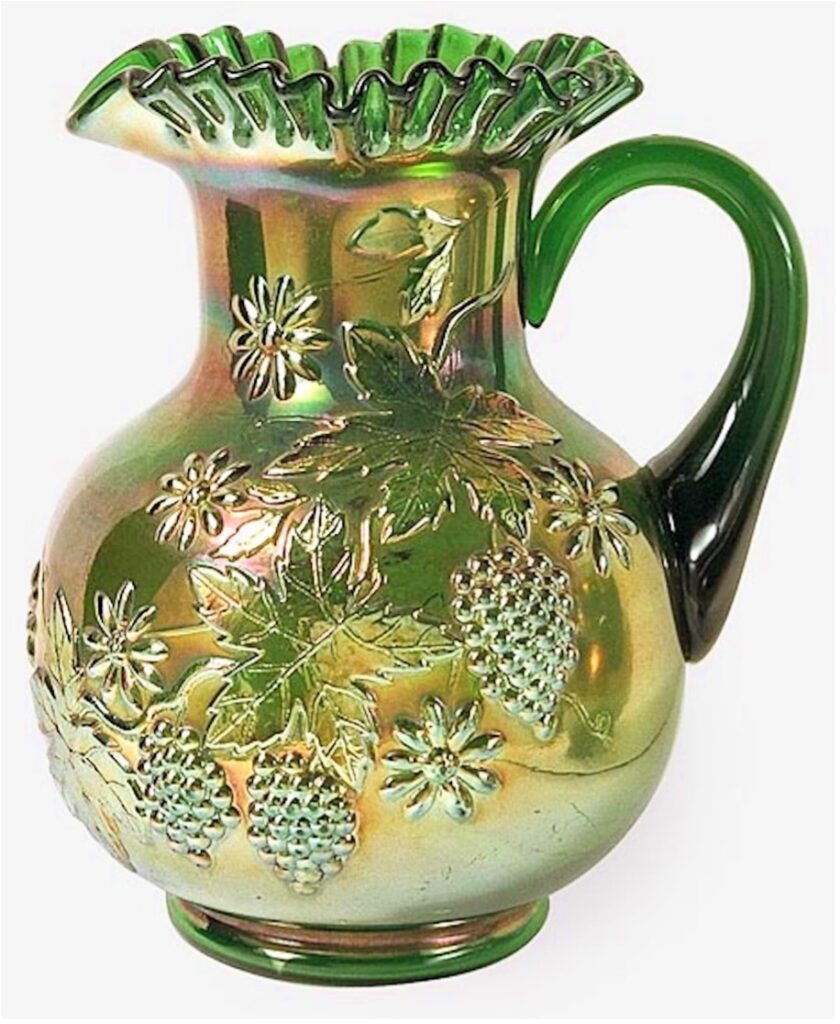
The Floral and Grape Variant pitcher in green may have been an early version of the conventional pattern. Are there other Variants besides this one?
Grace is an ICGA charter member. Byron joined ICGA a bit later and eventually served a term as ACGA president. They owned many rarities and ones-of-akind. Grace’s specialty was Kittens, a couple of cuspidors among them.
Two tables are provided. One summarizes differences between the Dugan-Diamond and Fenton pitchers; the other, the tumblers.
I am grateful to several collectors for content. They include: Carl and Eunice Booker for their collective historical memory, Lane Booker for checking dates, Barb Chamberlain for the JIP and pitcher photos, Kris
Dorais for details on Bob Smith’s contributions to NECGA, Dave Doty for the photos of the Fenton whimsey vase and pattern variant pitcher, the Hamlets for measurements and the account of how the vase became theirs, Brian Foster for last-minute help in solving a mystery, Diane Highnam for photographing the “Tilton tumbler,” Christina Katsikas for photos of the Smith collection tumblers, Kate Lavelle for observations on plant life, and Connie O’Connor for commentary and photos of pitchers, including those in the “At a Glance Comparisons” which follow.
Pitchers: Distinguishing the Dugan and Diamond from the Fenton
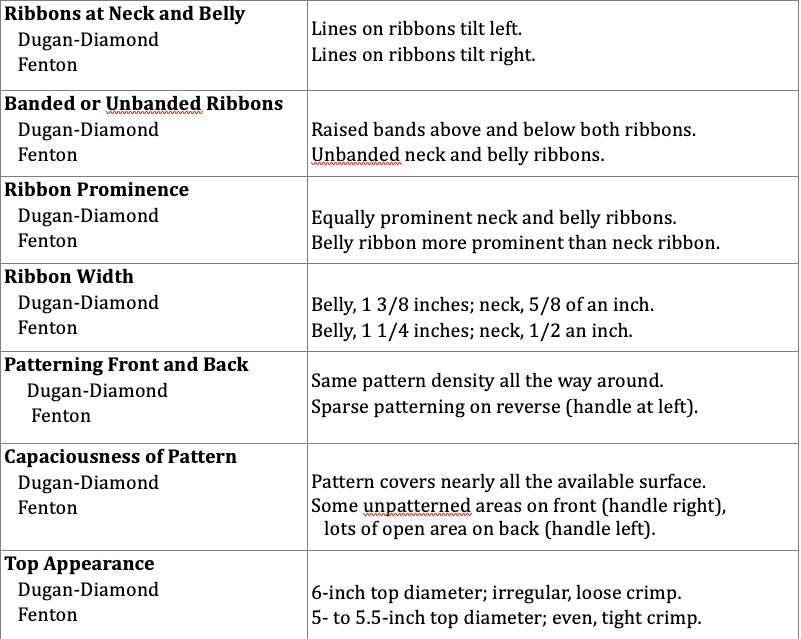
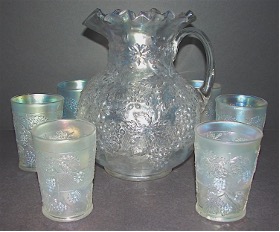
Tumblers: Distinguishing the Dugan and Diamond from the Fenton
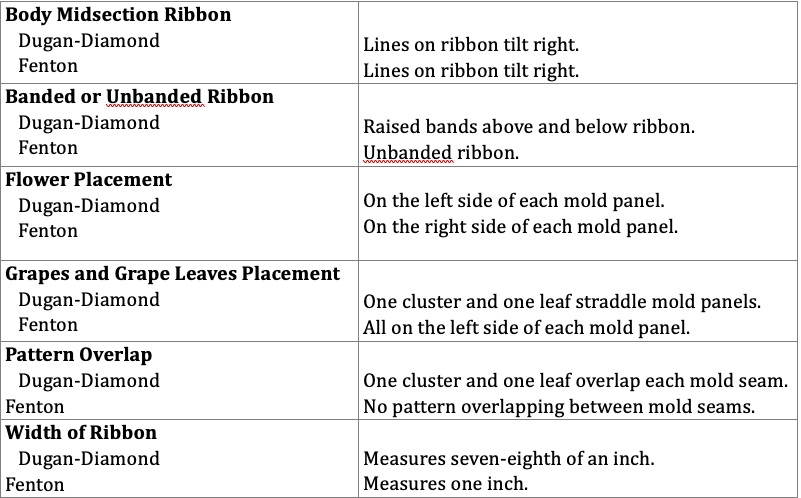
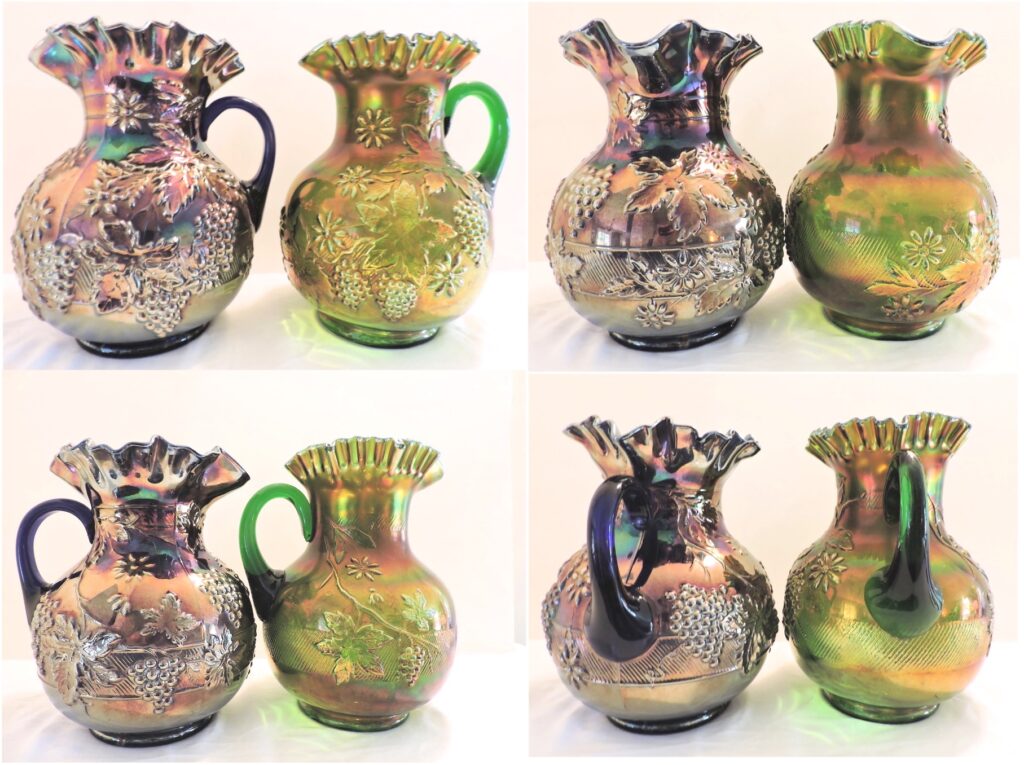
At a Glance Comparisons Dugan-Diamond and Fenton Floral and Grape Pitchers
Connie O’Connor has provided side-by-side comparisons of Dugan-Diamond and Fenton pitchers from four angles.
The Dugan are on the left; the Fenton, the right.
This article first appeared in the ICGA Pump in the September 2018 issue and is reprinted with permission.
